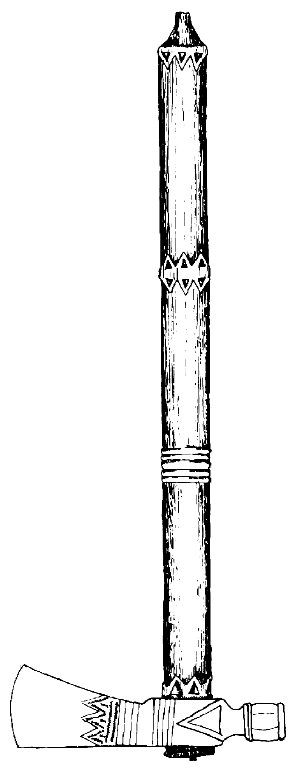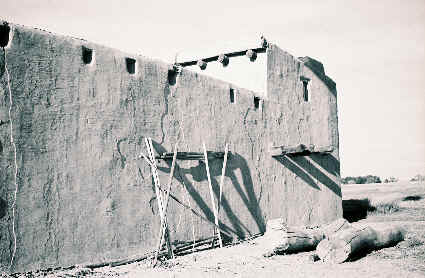|
|
||||
| .... |
|
.... |
_______________________ A YEAR IN A LIFE OF A MOUNTAIN MAN
|
.... |
|
As it always seems, we who research a particular period or specific type of person, pick up little bits and pieces of information. These are enough to keep us searching, provide small chunks of vital facts that help piece things together and encourage us to go on. So it is with us who learn about the mountain man era. We have the rendezvous' down pretty well. Journals and research give about all we can find on this. The "winter quarters" area, we are learning more about, but what about the other months of the year? Did the mountain man rendezvous all year? Did they stay in one general area for extended periods of time? Let's try to piece together a full year's time table for the average man in the mountains. If a "green horn" would head out to the "shining mountains" lets say from St. Louie, he would generally start in the spring. This would give him the maximum time to get settled, put a few plews on his pack animal and be settled in before winter settles in. It was also the best time, since snow would be gone from the plains, forage would be good for your horses. The trails would be in good shape (if not soft because of spring rains). SPRING: Time to leave the fort (or settlement) and make your way to the mountains! The caravans from the east made it in about eighty days. You might by yourself or in a small group, be there in two months. You need to plan for the trip beforehand, and get equipment on hand like: figuring out how many pack animals you will need per man, what kind of traps to get and how many, which food supplies are best and how to carry them, will your gun be right for your needs in the west? How much powder and lead to carry with you for the length of your stay. Repairs need to be done now or planned for, since they are either nonexistent or will cost you a lot more on the trip or in the mountains. Are the horses you have now up to the long trip to the mountains or is trading them off an option to look in to? Don't want to be caught out five hundred or one thousand miles and realize that you forgot some small but important detail. Choose your equipment and supplies well. M any a beginning mountain man has been taken by slick talking salesmen. Also might be a good idea to have a general area in mind of where to go to, since the mountain ranges cover a big area and no matter what everyone says, there isn't beaver in every creek and stream. SUMMER: Normal activities you will be doing are: exploring the region and check for beaver ("sign"), is the area a place you would find Indians? Are there enough plews to be taken in that area to merit time spent? Or did your "friend" give you a line on a great place to go to get you out of his hair? If so, better use your time wisely and find a good place to set traps. Learn if the natives are friendly or not. Would they be a good tribe to winter with? Or marry into? In some years, rendezvous would be going on in late summer. They lasted about an average of eighteen days- better be there! Supplies come but once a year to where you are so if not purchased now, they will not be had except by going back to the states or to the closest fort. (If you are lucky, you could find some of them "on the prairie".) Presents and "fofarraw" need to be found, special items bought for good friends, and your trade items gotten. FALL: Trapping starts now, but the furs are not yet prime. Some years had a rendezvous going on now, but most were in late July to mid August. It is a good time to make your plans, if not already settled on where to trap for fall and winter. Fall hunting is about to start, hides need to be gathered, meat dried, a place "to winter" chosen. (And with whom.) A "cache" might fit in your plans, so you don't have to lug all the furs and property you have around and lose everything you worked for if robbed. How are your eastern clothes holding up? Probably many things are wearing thin or completely gone. Is it time to get a better set that will last? There are many hard working days ahead and your clothes shouldn't be a worry on your mind.
|
WINTER: Trapping in full swing till streams and ponds freeze over, then "winter quarters" were found and camp was set up. A busy day would start before dawn, running traps that were set the day before. Bringing back to camp the day's catch, skinning and scraping the hide, putting them on stretchers, hunting and cooking your food for the day, maybe getting a wink of sleep before going out at dusk, moving and setting traps for the next day's run. Time also has to be made for warming up by the fire, mending, talking to your companions about where the sign was found and if any moccasin tracks were found that shouldn't be there. Might be a good time if game is close, to put in extra meat. It could come in handy. Some groups of men took as long as three weeks to get all ready for "winter quarters", if they didn't find a good tribe to be with. They would set out the coldest time enjoying themselves (if they chose a good place and planned correctly). Some would be r ecuperating from the years' injuries. Rocky mountain college is in full swing for the "tenderfoots" and "flat-landers." But, time can drag on if not prepared. Do you have any good books, and do you have a friend that can read them if you can't? Any musical instruments or games to play? SPRING: Time to brake out of winter's quarters. You have been in the mountains for a full year, and if you survived this long, you are well on the way to being a bonefide "hiverant." Contacts have been made and you are getting to know and be known by other mountain men. Hope you chose a good partner or two this last year, or now is the time get new one. Was the last year's catch good? Or at least are you a good game and card player? (Could make up for having a bad year with those.) Did you make a "cache?" Did you do it right? Time to brake into it and see how you did. So, was living out in the mountains worth all the trouble? Sleeping on the cold ground, wading in frigid streams, fighting Indians along with nature's storms, took a toll on you. Are you staying, or going on a long trip back to the settlements? Remember, the above year's routine would be for a "free trapper," not a engage' or a "boss man" (booshway) or even a French voyager. A company man would be tied to his group, so what they wore, where they went and what they did, he did. The booshway of a group or company would have to return to the states each year to get the furs to market, sell them, complete books, and get backers (if needed) for next years' trip again to the mountains. (And all the arrangements and licenses that needed to be done with that.) You might even start out as a company man, be a hunter, cook, game keeper or a clerk. They weren't all trappers. This cycle would happen each year. As a roving "mountaineer" you would need to be on the move for many reasons: lack of furs in an area you know, hostile Indians, another trapping group or company might like your area and chose it also, or just traveling to and from rendezvous. The mountain men are credited with exploring and discovering many new areas and you would be no different. There were times for resupplying for the coming year, being lazy, and times for down right hard work. And the mountain man did all these with gusto! The next time you read a journal or biography of one of these men, trace a full year's experiences. We tend to think our beloved fellows as only spending time drinking and carousing at a short period of the year called "rendezvous." But, no! Life in the mountains was a lot more interesting than just that. For the serious reenactor, we need to learn and portray all we can about the complete life of our main character - the mountain man. And what a set of characters they were. _______________________ See you down the trail
|
|||
|
documented facts
& stories pertaining to those than went before us.
Page 4 |
||||

 Mike
Moore, a staff writer on the western fur trade for "On The
Trail" magazine, has written for that magazine and others. It
took over five years to do the research and compile the chapters. You
may have seen an article by him in some of the following magazines:
Mike
Moore, a staff writer on the western fur trade for "On The
Trail" magazine, has written for that magazine and others. It
took over five years to do the research and compile the chapters. You
may have seen an article by him in some of the following magazines: